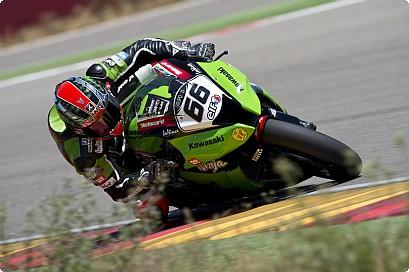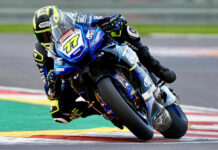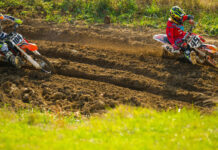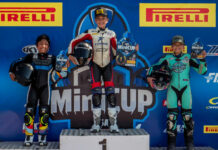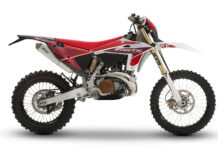Inline Fours: The Height Of Fast Fashion There was a recent consensus in Superbike World Championship racing that the days of the ‘conventional’ four-cylinder race machine were coming to a close. And closing day was accelerating towards us. If you didn’t use a twin, a vee, or a simulated twin, you were about to become an endangered species on the SBK podiums. Given the overall results of the races in 2012 so far, with the Kawasaki Ninja ZX-10R well in the leading group, that thinking is already out-of-date. Why? Largely because of the arrival in the inline four-cylinder SBK world of another three word phrase connected by hyphens – ride-by-wire. Or, if you go back to its original engineering application, fly-by-wire. Or, in the terminology of KHI’s Kawasaki Racing Chief Ichiro Yoda, drive-by-wire. Hereafter we will be calling it DBW, but whatever you call it, its adoption by all the top manufacturers in SBK racing as the way to control final throttle opening is probably the main reason why so far conventional fours have won six races, spread across three manufacturers. Four riders of these types of machines find themselves inside the top six places just after the halfway point of the season. “I can say that the biggest difference between last year and this year is engine management,” said Yoda-san, who has already seen Tom Sykes win a race on a DBW-equipped Ninja ZX-10R in 2012 and finish on the podium six times. Six pole positions can also be added to the haul of measurable and increasing success for Kawasaki’s DBW ‘screamer’. “Basically, the DBW concept is a big help for the racing four-cylinders,” continued Yoda. “Normally they have good power but it is difficult to get the best power delivery from zero throttle to maybe 40-50% throttle. In this area the four-cylinder is a bit aggressive, and there is also some delay in response. So from throttle to rear tyre the linearity is a little bit less than others – the vee-four engine and the vee-twin engine. With this DBW system, it helps in this area. Kawasaki did not have this last year. So DBW and Engine Management systems help a lot. Honda started at the end of last year, Suzuki now also, BMW already has it – and all these four cylinder machines go forward. So, it looks like together they realise that what we can do, they can do, and vice-versa.” The good news for fans of the Kawasaki Racing Team is that there is still more to come from the official Kawasaki entry. “Even if we put out more power the DBW system can manage it,” said Yoda. “It can make things more friendly to the rider and more easy to ride, so it looks like with the in-line fours, the current package, we can increase the power. That means we can still be better in the future. Our bike is a year-and-a-half old but it still has more potential.” Another part of the reason for Kawasaki’s recent improvements in SBK is the experience of some of the personnel involved, and a more direct path back to the home factory KHI in Japan. “I think there is a lot of knowledge from MotoGP in this paddock now, in our teams and others. As far as the software for the engine management and DBW is concerned, KHI makes the software back in Japan, from MotoGP experience. We found some good hardware when we worked in MotoGP, so we brought the complete package over here. We have basically the same number of sensors on the Superbike too. We have DBW but ours is a bit different from the others, I imagine. We also found this out in MotoGP.” It is a two-way street back to Japan of course, as what is learned in the racing world also helps with street machine development back home. “The factory effort from Kawasaki has increased and also with these kinds of good results the factory has more interest. When I go back to Japan I feel they have more interest. They watch the results and they like to use this kind of direction for the next model. Kawasaki aim to continuously develop the Ninja ZX-10R and we will use SBK to do this. Our new models will benefit directly from our race inputs. The current technology we are using means our production engineers have a lot of interest. So they would like to pick up some answers for the next model.” One clear unique joint effort in the design of the latest Ninja ZX-10R is the rear suspension and swingarm set-up, called the Horizontal Back Link. In racing, it helps in a few ways. “In the sessions we do not change the shock often, but it is an advantage to be able to do it so quickly. This shock location came from the production idea, so it is not so much for the racing. But it also looks like this layout has some benefits for racing at the moment.” As Superbike is a production-derived category, albeit a silhouette class most of all, the bike you start off with has a lot to do with ultimate track success, as Yoda explains. “We design the bike to be as good as it can without the electronics, and have as much power as possible. We are always looking for maximum power. In KHI full racing engineers are not so many, around seven or eight, and with Akira Technology, our engine partner, maybe three or four. But KHI is a very big company and we have many connections to other departments. We have a good connection to the overall R&D centre. So if we have some issue, we can put it on the table and we can discuss together. The main engineer numbers are small, but the group is big; big enough.” The other key to success in modern SBK racing is co-operation with partners, other technical collaborators who help each other and learn from each other. In this, Kawasaki also believes it has made good technical agreements. “Our suspension partner Showa has quite an involvement. Other brands are a little bit less involved for each team because they have a lot of customers in the SBK paddock, but Showa only has Kawasaki. Showa wants to produce better equipment so they put in a lot of energy to progress their products. So they progress quite quickly. This is also our advantage. For the engine, Akira Technology and Kawasaki have a good relationship. Regular maintenance is done by Akira, and other things on the engine side. We also get great product development from our other partners, like LeoVince and MRA, plus Brembo and many others.” In summary, given the performance of the straight fours and with Kawasaki one of the shining examples, we can say hello again to the latest engine concept to make a real push for the title in SBK racing. The reborn inline transverse four-cylinder. In the showrooms, and on the podiums again, near you.
Kawasaki World Superbike Team Claims Ride-By-Wire Throttle Systems Key To Success Of Inline Fours In 2012
Kawasaki World Superbike Team Claims Ride-By-Wire Throttle Systems Key To Success Of Inline Fours In 2012
© 2012, Roadracing World Publishing, Inc.
